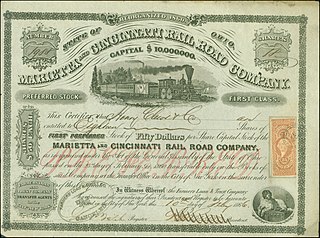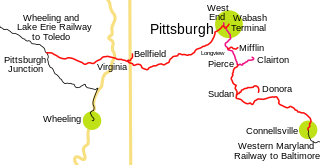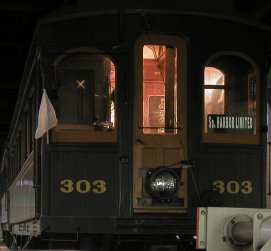The Central Ohio Railroad was the third railroad to enter Columbus, Ohio, and the first to connect Columbus with the east coast. It eventually became a part of the Baltimore and Ohio Railroad.
The Central Ohio Railroad was the third railroad to enter Columbus, Ohio, and the first to connect Columbus with the east coast. It eventually became a part of the Baltimore and Ohio Railroad.
It was realized that a railroad from Bellaire on the west side of the Ohio River across from Wheeling would be a valuable franchise for moving goods to and from the east coast. Chartered in February, 1847 by interests in Zanesville, the CO was to prove difficult to construct.
Eastern Ohio proved a difficult location for a railroad. Obstacles included the Muskingum River at Zanesville, 700 feet (210 m) of excavation through the hard sandstone of the Blackhand Gorge along the Licking River between Zanesville and Newark, and large quantities of fill and trestle work along the Big Walnut Creek. A tunnel in Cambridge had rockfalls and a cut near Barnesville had landslides.

On January 19, 1852, trains began running between Zanesville and Newark. [1] A year later trains ran from Newark to Columbus. Finally, in November 1854 the entire line was open between Bellaire and Columbus. The Baltimore and Ohio Railroad had been completed from Baltimore through Pittsburgh to Wheeling in 1852, so rail through rail service, except for the Ohio River Crossing, was afforded from Columbus to Baltimore and on to New York City. The railroad entered Columbus from the east passing near what is now Port Columbus Airport, crossed Alum Creek and Nelson Road south of Fifth Avenue and past the Barracks where it swung around southwestward to enter Union Station.
The poorly constructed line had an unballasted roadbed, and damage to engines and cars due to derailments was expensive and frequent. A lack of passing sidings rendered regular schedules impossible to meet. There weren't enough freight and passenger cars, and the maintenance facilities were inadequate. Due to the expense of constructing the line, no more credit was available to fix these shortcomings. The CO attempted to pay off its indebtedness from revenue, but fell into receivership in 1857 where it remained for several years.
Due to wartime revenue and traffic increases, the CO was able to exit bankruptcy in December 1865. The B&O, which had acquired an interest in the CO to keep it going during the war, leased the railroad and began a capital improvements program. In 1871 a stone and steel bridge crossed the Ohio River between Bellaire and Wheeling, greatly improving service. Part of the bridge infrastructure included the B & O Railroad Viaduct. The line remained a part of the B&O Railroad although parts of it were shared with the Pennsylvania Railroad in later years.
In the late 1980s the rail line east of Cambridge was abandoned and the track was taken up. The remaining rail line became part of the Columbus & Ohio River Railroad (CUOH) and is now part of a 247-mile (398 km) short line freight railroad that interchanges with CSX Transportation, Ohio Central Railroad, Ohio Southern Railroad and Norfolk Southern and has been operated as part of Genesee & Wyoming railroad, since it was acquired by them in 2008.

The Baltimore and Ohio Railroad was the first common carrier railroad and the oldest railroad in the United States with its first section opening in 1830. Merchants from Baltimore, which had benefited to some extent from the construction of the National Road early in the century, wanted to do business with settlers crossing the Appalachian Mountains. The railroad faced competition from several existing and proposed enterprises, including the Albany-Schenectady Turnpike, built in 1797, the Erie Canal, which opened in 1825, and the Chesapeake and Ohio Canal.

The Marietta and Cincinnati (M&C) was one of five important east-west railroads of southern Ohio; it was later absorbed by the Baltimore and Ohio Railroad (B&O). Its original route ran from Marietta through Vincent, Athens, Hamden, Chillicothe, Greenfield, Blanchester, and Loveland. It had two main branches: Blanchester to Hillsboro, which was originally part of the Hillsboro and Cincinnati Railroad; and Hamden to Portsmouth, Ohio, originally part of the Scioto and Hocking Valley Railroad.

The Cincinnati, Lebanon and Northern Railway (CL&N) was a local passenger and freight-carrying railroad in the southwestern part of the U.S. state of Ohio, connecting Cincinnati to Dayton via Lebanon. It was built in the late 19th century to give the town of Lebanon and Warren County better transportation facilities. The railroad was locally known as the "Highland Route", since it followed the ridge between the Little and Great Miami rivers, and was the only line not affected by floods such as the Great Dayton Flood of 1913.

The Wheeling Suspension Bridge is a suspension bridge spanning the main channel of the Ohio River at Wheeling, West Virginia. It was the largest suspension bridge in the world from 1849 until 1851. Charles Ellet Jr. designed it and supervised construction of what became the first bridge to span a major river west of the Appalachian mountains. It linked the eastern and western section of the National Road, and became especially strategically important during the American Civil War. Litigation in the United States Supreme Court concerning its obstruction of the new high steamboat smokestacks eventually cleared the way for other bridges, especially needed by expanding railroads. Because this bridge was designed during the horse-and-buggy era, 2-ton weight limits and vehicle separation requirements applied in later years until it was closed to automobile traffic in September 2019.

The Western Maryland Railway was an American Class I railroad (1852–1983) that operated in Maryland, West Virginia, and Pennsylvania. It was primarily a coal hauling and freight railroad, with a small passenger train operation.
The Wheeling and Lake Erie Railway is a Class II regional railroad that provides freight service, mainly in the areas of Northern Ohio and Western Pennsylvania. It took its name from the former Wheeling and Lake Erie Railway, most of which it bought from the Norfolk and Western Railway in 1990.
The Cleveland Short Line Railway is a freight bypass around southern Cleveland, Ohio, in the United States. A quasi-independent railroad organized by major shareholders of the Lake Shore and Michigan Southern Railway, the shortline was intended to allow the Lake Shore and Michigan Southern to bypass the congested railroads in downtown Cleveland. The Cleveland Short Line has had a succession of owners, and is currently part of CSX Transportation.
The Pittsburgh, Fort Wayne and Chicago Railway was a major part of the Pennsylvania Railroad system, extending the PRR west from Pittsburgh, Pennsylvania, via Fort Wayne, Indiana, to Chicago, Illinois. It included the current Norfolk Southern-owned Fort Wayne Line east of Crestline, Ohio, to Pittsburgh, and the Fort Wayne Secondary, owned by CSX, from Crestline west to Tolleston in Gary, Indiana. CSX leased its entire portion in 2004 to the Chicago, Fort Wayne and Eastern Railroad (CFE). The remaining portion of the line from Tolleston into Chicago is now part of the Norfolk Southern's Chicago District, with a small portion of the original PFW&C trackage abandoned in favor of the parallel lines of former competitors which are now part of the modern NS system.

The Pittsburgh, Cincinnati, Chicago and St. Louis Railroad, commonly called the Pan Handle Route, was a railroad that was part of the Pennsylvania Railroad system. Its common name came from its main line, which began at Pittsburgh, Pennsylvania, crossed the Northern Panhandle of West Virginia, and continued west to Bradford, Ohio, where it split into a northern line to Chicago and a southern one through Indianapolis, Indiana, to East St. Louis, Illinois.

The Pittsburgh and West Virginia Railway was a railroad in the Pittsburgh, Pennsylvania, and Wheeling, West Virginia, areas. Originally built as the Wabash Pittsburgh Terminal Railway, a Pittsburgh extension of George J. Gould's Wabash Railroad, the venture entered receivership in 1908 and the line was cut loose. An extension completed in 1931 connected it to the Western Maryland Railway at Connellsville, Pennsylvania, forming part of the Alphabet Route, a coalition of independent lines between the Northeastern United States and the Midwest. It was leased by the Norfolk and Western Railway in 1964 in conjunction with the N&W acquiring several other sections of the former Alphabet Route, but was leased to the new spinoff Wheeling and Lake Erie Railway in 1990, just months before the N&W was merged into the Norfolk Southern Railway.
The Northeast and the Great Lakes states are connected by an east-west railroad corridor. The endpoints of this corridor are New York City and Chicago. Along the way, the corridor passed through cities such as Philadelphia, Baltimore, Washington, D.C., Pittsburgh, Buffalo and Cleveland. There were branches off the corridor to cities such as Cincinnati, Detroit, Indianapolis, and St. Louis. For over a century, this corridor was dominated by four major railroads, and an aggregate of other railroads that served as a fifth option.

Cleveland has been and continues to be deeply rooted in railroad history.
The CL&W Subdivision is a railroad line owned and operated by CSX Transportation in the U.S. state of Ohio. The line runs from a junction with the New Castle Subdivision at Sterling northwest to Lorain along a former Baltimore and Ohio Rail Road line. It junctions with the Cleveland Subdivision at Lester and the Greenwich Subdivision at Grafton.
Belmont Glass Company, also known as the Belmont Glass Works, was one of Ohio's early glassmaking companies. It was named after Belmont County, Ohio, where the plant was located. The firm began operations in 1866 in a riverfront village along the east side of the county, which is known as Bellaire. At that time, the community had resource advantages that made it an attractive site for glassmaking. Bellaire's location at the intersection of the Ohio River, the National Road, and two railroads meant it had an excellent transportation infrastructure. Fuel necessary for the glassmaking process was also readily available, since Belmont County was part of the eastern Ohio coal region. Bellaire also had a workforce with glassmaking expertise located less than five miles away, since glass had been produced in Wheeling, West Virginia, since the 1820s.
The Wheeling and Lake Erie Railway was a Class I railroad mostly within the U.S. state of Ohio. It was leased to the New York, Chicago and St. Louis Railroad in 1949, and merged into the Norfolk and Western Railway in 1988. A new regional railroad reused the Wheeling and Lake Erie Railway name in 1990 when it acquired most of the former W&LE from the N&W.

Henry Crimmel was an American glassmaker who became well known in Ohio and Indiana. A German that came with his family to America at the age of eight years, the American Civil War veteran started at the lowest level in glass making, and learned every aspect of the business. A skilled glassblower known for his glassmaking expertise and the recipient of two patents, he also worked in management in at least three glass factories – and was one of the co-founders of the Novelty Glass Company and the reorganized version of Sneath Glass Company. He retired with over 50 years in the industry.

The Columbus & Ohio River Railroad is a railroad in the U.S. state of Ohio owned by Genesee & Wyoming Inc.
The Valley Railway was a shortline railroad which operated between the city of Cleveland and small town of Zoarville in the state of Ohio in the United States. The railroad was founded in 1871, but the first segment of track did not open until 1880 and the line was not completed until 1884. The Baltimore and Ohio Railroad (B&O) obtained a controlling interest in the Valley Railway in 1890. The railroad went bankrupt in 1895, at which time it was reorganized as The Cleveland Terminal and Valley Railroad Company (CT&V). The B&O took over operation of the CT&V in 1909, and the company was merged with the B&O in 1915.
The Baltimore and New York Railway was a railroad line built by the Baltimore and Ohio Railroad (B&O) from Cranford, New Jersey, to the western side of the Arthur Kill Bridge in New Jersey, connecting with the North Shore Branch of Staten Island Rapid Transit. The line was built to provide the B&O access to a terminal in New York City, in Staten Island. Today, the line is used by CSX Transportation for freight trains.